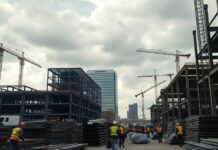The reinstatement of extensive tariffs by President Donald Trump in 2025 Construction tariffs is creating significant upheaval within the U.S. construction industry, which is heavily dependent on imported materials and goods. The tariffs imposed on essential trading partners like China, Canada, and Mexico feature a 25% charge on imported steel and aluminium, along with extra duties on construction machinery, electrical parts, and lumber. Although intended to bolster domestic manufacturing and mitigate trade deficits, these initiatives have raised apprehensions regarding escalating costs, disruptions in supply chains, and delays in project timelines within the sector.
The construction sector, responsible for around 50% of global steel consumption and 25% of aluminium consumption, is anticipated to face significant challenges due to these tariffs. The costs of imported materials, crucial for residential, commercial, and infrastructure developments, have now risen significantly. This situation has caused concern among contractors and developers, who are tasked with managing these obstacles while ensuring project timelines and budget constraints are met.
Impact on Material Costs and Supply Chains
The tariffs have resulted in a notable increase in the cost of raw materials. For instance, the United States depends on Canada and Mexico for more than 40% of its aluminium and 25% of its steel imports. The implementation of a 25% tariff on these imports is expected to result in a notable rise in material costs, exacerbating the pressure on already tight margins.
In addition to rising costs, supply chain disruptions are becoming a significant concern. Exporters from Canada and Mexico, who supply the majority of imported steel and timber to the U.S., may redirect their products to alternative markets in response to the tariffs. This scenario could lead to a shortage of critical resources, potentially exacerbating project delays and driving up expenses.
Challenges for Project Execution
The tariffs are transforming the project landscape for contractors in the U.S. Fixed-price contracts, prevalent in the construction sector, expose contractors to the risk of unforeseen cost escalations. With the increase in material prices, contractors could encounter financial setbacks or find themselves needing to revisit agreements with clients. Moreover, setbacks stemming from material shortages may lead to penalties or liquidated damages, adding additional pressure on contractors’ operations.
Major infrastructure initiatives, including bridges, tunnels, and public transportation networks, face significant vulnerabilities. The reliance on imported steel and aluminium for these projects means that tariff-induced cost increases may result in budgetary constraints and hinder progress. The ambiguity surrounding tariff policies further complicates long-term planning for construction firms, hindering their ability to accurately bid on future projects.
Opportunities Amidst the Challenges
In light of the challenges, the tariffs may offer avenues for growth for domestic manufacturers and suppliers. The implementation of tariffs could encourage the use of American-made materials, potentially fostering growth in domestic production. The rise in demand presents a significant opportunity for domestic steel and aluminium manufacturers, potentially resulting in job growth and enhanced investments in local production facilities.
Infrastructure projects supported by the government, frequently incorporating Buy American provisions, are likely to experience heightened activity as federal spending increasingly focuses on domestic suppliers. This has the potential to offer significant support to the construction sector, especially for firms focused on public works initiatives.
Broader Economic Implications
The construction sector is certainly not the only one experiencing the impacts of the tariffs. The housing market, already grappling with elevated interest rates and a lack of affordable homes, is expected to encounter additional challenges as the prices of building materials continue to climb. Homebuilders could transfer these expenses to consumers, resulting in new homes becoming less affordable and worsening the housing shortage.
The automotive and manufacturing sectors, which depend on imported materials, face similar challenges. The tariffs may result in increased costs for vehicles, appliances, and various other products, thereby adding to inflationary pressures throughout the economy.
Expert Opinions and Industry Reactions
Concerns have been raised by industry leaders regarding the effects of tariffs on the construction sector. Stephen Sandherr, CEO of the Associated General Contractors of America, highlighted the uncertainty introduced by the tariffs, noting that they complicate the ability of contractors to plan and submit bids with precision. There is a notable division among economists regarding the long-term implications, with some emphasising the possibility of domestic growth while others caution against inflation and a sluggish economic recovery.
Navigating the Path Forward
As the construction sector navigates the challenges posed by the tariffs, flexibility and thoughtful planning will be essential. Companies need to reevaluate their supply chain strategies, investigate alternative sourcing options, and think about renegotiating contracts to address price fluctuations. Investing in workforce development and technology, including automation and prefabrication, may serve to alleviate the challenges posed by increasing costs and labour shortages.
In summary, although the 2025 construction tariffs create notable obstacles for the U.S. construction sector, they simultaneously offer avenues for innovation and advancement. Utilising local resources, adopting innovative technologies, and promoting teamwork throughout the supply chain will enable the industry to tackle upcoming challenges and come out more resilient in the future.





























